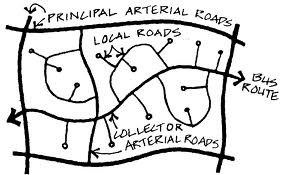A good planned city/town reacquires an efficient transport system. This can only be achieved if the town planner is well acquainted with different hierarchy of roads. Thus a town planner and transport planner must have a good understanding of hierarchy of roads in urban and rural areas.
A productive urban way system, accompanies an order. The hierarchy of road is dependent upon the function that the street is required to perform, and the kind of movement and the way users present. The outline speeds , way widths and other geometric characteristics are adapted to suit the way work. These guidelines are dependent upon the accompanying characterization of urban way:
- Arterial Roads: They are the primary roads & are on top in hierarchy of roads for guaranteeing versatility capacity. They convey the biggest volumes of movement and longest treks in a city. These are characterized by through movement with confined access from carriageway to the side. In such cases, unique provisions ought to be acquainted with decrease clash with the through movement. These roads have the most extreme right of way around the four classes and cater speed of 50-60 km/h and a ROW of 50-80 m.
- Sub Arterial Roads: This class of street takes after all the capacities of an Arterial Urban way and are portrayed by portability, and indulge through movement with confined access from carriageway to the side. It conveys same movement volumes as the arterial roads. Because of its overlapping nature, Sub arterial roads can function as arterials. This is setting particular and is dependent upon the capacity and the area use advancement it passes through and caters to a velocity cutoff of 50 km/h(same as arterial roads) .The ROW of this classification of streets changes from 30-50 m.
- Distributor/collector Roads: As the name recommends, these are connector ways which circulate the activity from access lanes to arterial and sub arterial roads. They are portrayed by portability and access just as. They are portrayed by a speed limit of 30km/h and have a ROW halfway of access lanes and two sorts of arterials i.e. 12-30m. It conveys moderate movement volumes contrasted with the arterial roads. Because of its covering nature, merchant streets can go about as a sub arterial roads and as access lanes, contingent on the capacity and the area utilization of the surroundings
- Access Streets: These are utilized for access capacities to bordering lands and regions. A greater part of excursions in urban regions normally begin or end on these streets.They cater to velocity of 15-30km /h and have a ROW of 15m-30m. They convey generally lower volumes of movement at low speeds. They are described by access prevalently; they could be utilized for gatherer capacities.
In view of the capacity the grouping of the ways is chosen and a suitable configuration velocity is adjusts. The configuration rate represents the geometric outline of the right of way and the cross segment components of the way. The standards for Hierarchy of Roads followed are different in different countries.
